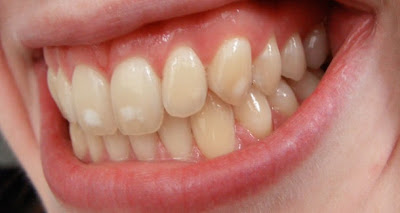High levels of flouride ingestion from dietary sources alone can place people at increased risk for developing dental fluorosis. (DTI/Photo courtesy of josconklin)
IOWA CITY, Iowa, USA: In order to determine the amount of fluoride that children receive from solid foods, researchers have assessed data on the diets of young children. They have discovered that some receive more than 80 percent of their dietary fluoride from solids, which might place them at an elevated risk of developing dental fluorosis.
According to researchers at the University of Iowa, children ingested the majority of dietary fluoride from beverages but a few subjects received substantial amounts of fluoride from solid foods alone. This demonstrates that solid foods can be important contributors to dietary fluoride intake, they said.
At 6 months of age, babies ingested an estimated 8 percent of dietary fluoride from solid foods. Baby foods provided the highest levels of daily fluoride intake. Between 12 and 60 months of age, children received an estimated 39 percent of dietary fluoride from solids. Grains, cereals and starches contained the highest levels. The percentage stabilized between 24 and 60 months (36 to 39 percent) but some children ingested as much as 85 to 88 percent of their dietary fluoride from solids at this age, the researchers noted.
The Institute of Medicine, an independent, nonprofit organization based in Washington, D.C., recommends an upper limit forfluoride intake of 0.7 mg/day from birth to 6 months, 0.9 mg/day for 7 to 12 months and 1.3 mg/day for 1 to 3 years of age.
According to the study, about 25 percent of children of 6 months of age ingested amounts greater than the recommended maximum intake. Between 12 and 36 months of age, 5 percent of the children ingested amounts greater than the tolerable upper limit. At 48 and 60 months of age, less than 1 percent of the children ingested amounts of fluoride greater than the tolerable upper limit.
According to the study, low levels of fluoride offer dental benefits to people of all ages. However, exposure to high levels can lead to the development of dental fluorosis.
Data was obtained from the Iowa Fluoride Study, a longitudinal investigation of a cohort recruited at birth from eight Iowa hospitals between March 1992 and February 1995. Parents were asked to complete a questionnaire on their child's diet over the course of three days at various points, starting at 6 weeks of age and ending at 72 months. The number of questionnaires completed at each stage ranged from 376 to 670. The majority of parents were white (97 percent) and of higher socioeconomic status (75 percent).
The study was published in the spring issue of the Journal of Public Health Dentistry.
Source : http://www.dental-tribune.com/articles/content/id/9145/scope/news/region/americas
IOWA CITY, Iowa, USA: In order to determine the amount of fluoride that children receive from solid foods, researchers have assessed data on the diets of young children. They have discovered that some receive more than 80 percent of their dietary fluoride from solids, which might place them at an elevated risk of developing dental fluorosis.
According to researchers at the University of Iowa, children ingested the majority of dietary fluoride from beverages but a few subjects received substantial amounts of fluoride from solid foods alone. This demonstrates that solid foods can be important contributors to dietary fluoride intake, they said.
At 6 months of age, babies ingested an estimated 8 percent of dietary fluoride from solid foods. Baby foods provided the highest levels of daily fluoride intake. Between 12 and 60 months of age, children received an estimated 39 percent of dietary fluoride from solids. Grains, cereals and starches contained the highest levels. The percentage stabilized between 24 and 60 months (36 to 39 percent) but some children ingested as much as 85 to 88 percent of their dietary fluoride from solids at this age, the researchers noted.
The Institute of Medicine, an independent, nonprofit organization based in Washington, D.C., recommends an upper limit forfluoride intake of 0.7 mg/day from birth to 6 months, 0.9 mg/day for 7 to 12 months and 1.3 mg/day for 1 to 3 years of age.
According to the study, about 25 percent of children of 6 months of age ingested amounts greater than the recommended maximum intake. Between 12 and 36 months of age, 5 percent of the children ingested amounts greater than the tolerable upper limit. At 48 and 60 months of age, less than 1 percent of the children ingested amounts of fluoride greater than the tolerable upper limit.
According to the study, low levels of fluoride offer dental benefits to people of all ages. However, exposure to high levels can lead to the development of dental fluorosis.
Data was obtained from the Iowa Fluoride Study, a longitudinal investigation of a cohort recruited at birth from eight Iowa hospitals between March 1992 and February 1995. Parents were asked to complete a questionnaire on their child's diet over the course of three days at various points, starting at 6 weeks of age and ending at 72 months. The number of questionnaires completed at each stage ranged from 376 to 670. The majority of parents were white (97 percent) and of higher socioeconomic status (75 percent).
The study was published in the spring issue of the Journal of Public Health Dentistry.
Source : http://www.dental-tribune.com/articles/content/id/9145/scope/news/region/americas

Comments
Post a Comment